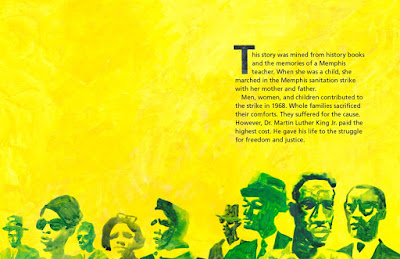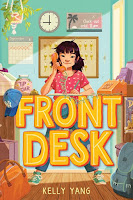As I continue to celebrate 10 years of blogging, I want to turn to books that encourage us to speak our truths. While books can't change the world, they can help give us the courage to stay true to our beliefs, to do the right thing in difficult situations. These stories focus on young people courageously speaking up for themselves in the face of difficulties.
Anger Is a Gift, by Mark Oshiro: Black teen Moss struggles with panic attacks and anxiety, a result of his father's death from police brutality six years earlier in Oakland, CA. When school administrators bring armed police in for random locker searches and install metal detectors, Moss and his friends organize a protest. I especially appreciated how Oshiro balances Moss's personal journey and the way his community comes together to protest the authoritarian administration. A powerful book, with an authentic local setting, for fans of
The Hate U Give. (
ages 14-18)
Front Desk, by Kelly Yang: Mia's family has recently immigrated from China, and finding a steady job has been really tough for her parents. When an opportunity to manage a motel comes their way, they leap at it. Mia's excited that she can help out, managing the front desk while her parents clean the rooms. Kelly Yang bases this story on her own experience, immigrating from China to Los Angeles. She weaves humor and compassion into her story, speaking from her personal experience to frankly address poverty, bullying and the importance of family. (
ages 8-12)
Ghost Boys, by Jewell Parker Rhodes: After being killed by a white police officer, a 12 year old black boy returns as a ghost to process what has happened and how it is affecting his family. The ghost of Emmett Till, a black boy murdered in 1955, and other "ghost boys" who have been murdered, help Jerome understand the larger historical context. The chapters jump back and forth in time, weaving together the social and political framework to help young readers grapple with the impact of police violence on communities of color. (
ages 10-15)
I Have the Right To: A High School Survivor's Story of Sexual Assault, Justice, and Hope, by Chessy Prout: As a freshman at St. Paul’s School in New Hampshire, Chessy Prout was sexually assaulted by an upperclassman. In her raw and honest memoir, Prout shares her experience of assault and the subsequent journey with the tumultuous trial, media attention and search for healing and change. As I read this, I was particularly angered by the way the school resisted Chessy's search for justice and struck by how the legal system does not help our young people find the resolution they need. A powerful memoir. (
ages 13-18)
#Notyourprincess: Voices of Native American Women, by Lisa Charleyboy: This anthology shares the voices, art, poetry, and insight of modern Native women about their life experiences--the good and the bad, the joyous and the painful--creating a powerful message of the importance of speaking the truth and being visible in a culture that it so often dismissive or manipulative. I especially appreciate the wide diversity of Native women that is represented here. Brilliant and moving collection. (
ages 12-18)
The Prince and the Dressmaker, by Jen Wang: Prince Sebastian feels comfortable identifying both male and female, often wearing dresses and going out as his alter ego, Lady Crystallia. When he hires Frances, a young seamstress, to make him a wardrobe of boldly beautiful, dazzling dresses, Frances hesitates at first, but they soon discover a shared passion for fashion. Incorporating the feel of classic fairytales, Wang creates a story that revolves around friendship, following your dreams and speaking your truth. (
ages 10-15)
The Poet X, by Elizabeth Acevedo: A first-generation Dominican-American, fifteen-year-old Xiomara struggles balancing her mother’s strict Catholicism with her own desire to find her place in the world. Writing poetry helps Xio come into her own, channelling her feelings, worries and questions in her journal, as she explores her blossoming romance with Aman, her science partner. As Xio starts figuring out how she can stand up for what she believes, she discovers the power of her voice through the poetry club at school. This powerful coming-of-age story poignantly speaks to teens finding their voice. (
ages 13-18)
Stella Diaz Has Something to Say, by Angela Dominguez: Stella is shy, self-conscious about her accent and the way she jumbles Spanish and English when she can't find the right word. As third grade starts, she's also worried about being in a different class from her best friend Jenny. I especially appreciate how Stella's Mexican-American family supports her and cheers her on as she discovers her courage and voice. (
ages 7-10)
Swing, by Kwame Alexander: Noah, Walt and Sam (Samantha) have been best friends since elementary school, but ever since they got to high school, Noah hasn't been able to figure out how to tell Sam that he really likes her. No matter how much Walt (aka Swing) encourages him to take a chance, Noah struggles to express his feelings for Sam. Inspired by love letters he finds in a thrift store, Noah finally starts to put his feelings onto paper using both art and poetry. While I related to Noah, I was utterly charmed by Swing's humor and optimism. Readers will want to talk when they reach the end--be there for them, as they find their voice about the larger issues impacting our society. (
ages 13-18)
The Witch Boy, by Molly Ostertag: This graphic novel will appeal to readers with its magical setting and strong protagonist. In Aster's village, there are very clear expectations: girls will learn witchcraft and spells, while boys will learn to become shapeshifters. Yet Aster yearns to learn the spells that his sister is perfecting, and is not interested in the other boy's aggressive play. When several boys go missing, Aster tries to use his developing magical abilities to solve the mystery. I especially appreciated the way Aster questions society's gender expectations and stays true to himself. A delightful graphic novel -- I'm looking forward to reading the sequel,
The Hidden Witch, which has just come out. (
ages 8-12)
If you make a purchase using the Amazon links on this site, a small portion goes to Great Kid Books. Thank you for your support.
©2018 Mary Ann Scheuer, Great Kid Books


















































